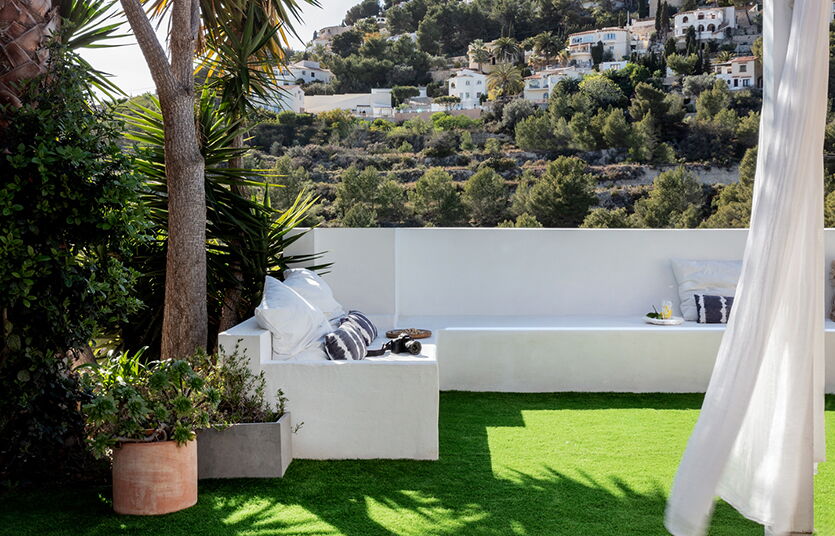Artificial grass: 6 myths debunked
What persistent myths about artificial grass are out there? Here are 6 myths about artificial grass that need debunking. How many of them do you think are true?

6 myths that need debunking
Looking forward to all the hard labour required to get (and keep) your lawn in shape? Can’t wait to take your biweekly stroll through the garden – behind that noisy old lawnmower? If you want a perfect lawn – all year long –, without all that effort, you may have already considered installing artificial grass. But you also might have heard some misconceptions that stopped you from making a choice. What persistent myths about artificial grass are out there?
Here are 6 myths about artificial grass that need debunking. How many of them did you think were true?
- Artificial grass implies high costs
- Artificial grass is not suitable for children
- Artificial grass is not safe for pets
- Artificial grass looks fake
- Artificial grass is prone to drainage problems
- Artificial grass is bad for the environment
1. Artificial grass implies high costs
Many people believe that they can’t afford artificial grass. It’s just too expensive to install. But – and this might surprise you – artificial grass costs less than natural grass in the long run.
How is that possible?
It’s true that artificial grass requires a higher up-front investment. However, there are a lot of expenditures required to maintain a natural lawn that simply aren’t applicable to artificial grass. You can save a considerable amount of money on:
- Maintenance – you don’t need fertilisers, grass feed or pesticides to keep your grass healthy and green.
- Water consumption – you don’t have to water artificial grass, which reduces your water consumption costs.
- Tools – you don’t need to buy a lawnmower or other expensive gardening tools, saving you hundreds of euros every couple of years.
All these savings add up, making artificial grass an even more cost-effective choice than a natural lawn. You can benefit from a lower total cost of ownership five to seven years after installing an artificial lawn.
2. Artificial grass is not suitable when you have children
Early artificial grass types might have been hard and scratchy, but a lot has changed over time. The materials that are being used now are much closer to real grass in texture, making them safe for kids to play on.
Turfgrass, for example, feels soft and doesn’t irritate children’s sensitive skin. It is manufactured in Europe using non-toxic materials, making it the best artificial grass for kids.
3. Artificial grass is not safe for pets
Another misconception about artificial grass is that it’s bad for animals, but we can assure you that it’s perfectly safe for your beloved dog, cat or other pet. They will love rolling around in it just as much as they would on natural grass. What they won’t be doing, however, is digging holes, leaving yellow urine stains on your green lawn or entering your house with muddy paws ever again.
These are valuable advantages for pet owners and their pets who want to fully enjoy playtime in their lush gardens without worries, don’t you think?
4. Artificial grass looks fake
When choosing artificial grass, you want to make sure that you select the most appropriate type, colour, pile height and density for your garden and personal wishes.
Of course, you also want it to look like the real thing. Well, we have good news for you: our top-notch Turfgrass collection not only feel realistic, but they also look splendid too. It takes a trained eye to tell the difference.
5. Artificial grass is prone to drainage problems
If you want to enjoy your artificial lawn for a long time, the number one priority when laying it is making sure you have sufficient draining.
When installed correctly, the draining system will protect your garden against flooding and heavy rain, regardless if the surface underneath your artificial grass is hard concrete or soft soil.
6. Artificial grass is bad for the environment
As we already pointed out, artificial grass, unlike natural grass, doesn’t have to be watered. This enables you to save money and time while also reducing your ecological footprint. In short, by choosing Turfgrass you take care of the environment.
Need exact figures? It is estimated that an artificial lawn may help you to reduce your water consumption by 2920 to 3650 litres per year. That’s a significant amount of water saved, right?
Artificial grass also doesn’t have to be fertilised or sprayed with pesticides, keeping these harmful chemicals from finding their way into the soil and groundwater.
On top of that, Turfgrass artificial grass is 100% non-toxic and 100% lead free. By minimising the amount of water and additives used during our production processes, we further contribute to a healthier environment.